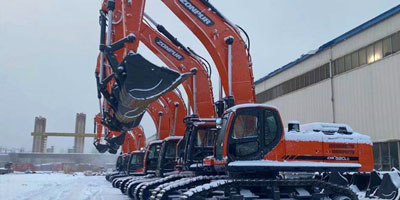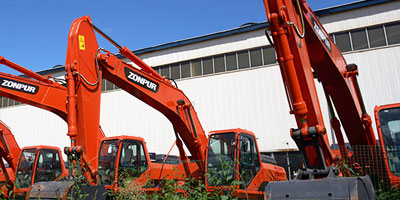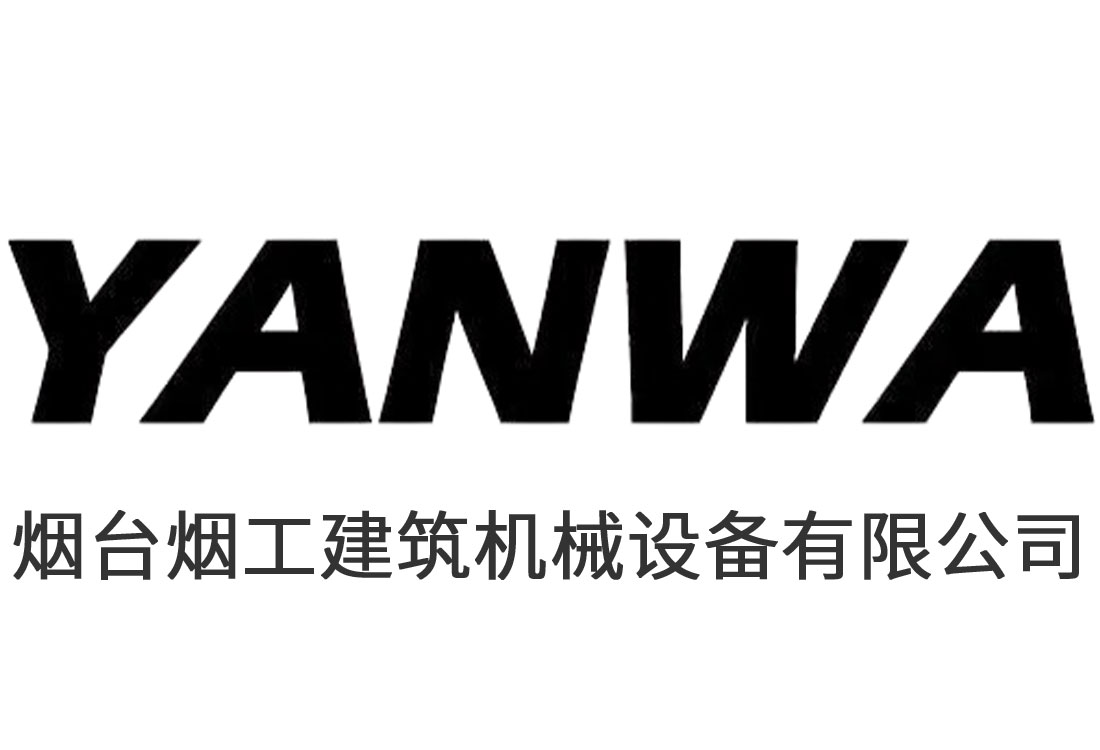High oil temperature during excavator operation not only affects machine performance, but may also shorten component life and even cause malfunctions. To effectively cool down and prevent overheating again, we can start with maintenance of the cooling system, equipment operation management, oil selection and monitoring, and other aspects.
Maintenance of cooling system
1. Cleaning of radiator
Regular cleaning: The surface of the radiator is easily covered by dust, dirt, leaves, and other debris, which hinders heat dissipation. It is recommended to regularly (at least once a week) use compressed air or a high-pressure water gun (pay attention to moderate pressure to avoid damaging the radiator fins) to blow or rinse from the back (fan side) of the radiator forward to remove any attached debris.
Internal descaling: After prolonged use, scale may form inside the radiator, reducing heat exchange efficiency. Special cooling system cleaning agents can be used, added to the cooling water according to the instructions, discharged after running for a period of time, and then rinsed with clean water to ensure smooth internal water channels. Generally, internal descaling should be carried out at least once a year.
2. Fan inspection and maintenance
Fan blades: Check whether the fan blades are damaged or deformed. If such a situation exists, it will affect the air volume and blowing effect of the fan. If the blades are damaged, they need to be replaced in a timely manner; For slightly deformed blades, correction can be attempted, but when severely deformed, new blades should be replaced.
Fan belt: Check the tension of the fan belt. If it is too loose, the belt will slip, causing the fan speed to decrease and affecting heat dissipation; Tightness will increase the wear of the belt and bearings. Usually, the middle of the belt can be pressed with the thumb, with a recommended downward pressure of 1015 millimeters. If it does not meet the requirements, adjust the belt tension by adjusting the device, and check whether the belt has cracks or wear. If necessary, replace it.
Fan coupling: For excavators using silicone oil fan coupling, check if the coupling is working properly. If the coupler fails, the fan may not be able to automatically adjust its speed according to the oil temperature. After the engine is running and the oil temperature rises, you can feel the change in fan speed. If there is no significant change in fan speed, it may be a problem with the coupling and it needs to be repaired or replaced.
3. Sealing inspection of the cooling system
Cooling water pipeline: Carefully inspect the connection parts of the cooling water pipeline, including the connection between the hose and the hard pipe, the interface between the water pipe and the radiator and engine, etc., to see if there are any signs of coolant leakage. If coolant leakage is found, tighten the pipe clamp or replace the sealing gasket in a timely manner. If the water pipe ages or ruptures, it should be replaced with a new one.
Heat sink core: Check if there are any leakage points in the heat sink core. You can inspect the appearance for coolant traces or use a specialized heat sink pressure tester for testing. If there is a leakage in the core, welding repair can be attempted for smaller leakage points, and in severe cases, the radiator core needs to be replaced.
Equipment operation management
1. Reasonable load operation
Avoid overload: Strictly operate according to the rated working capacity of the excavator and avoid working for a long time beyond its load. Overloading operations can put excessive pressure on the engine and hydraulic system, generating excessive heat. For example, when excavating harder rocks or loading overweight materials, forced operations should be avoided, and appropriate crushing or batch loading methods can be adopted.
Control working hours: Long term continuous operation will cause the oil temperature to continuously rise. The working time should be arranged reasonably. Every 23 hours of operation, the equipment can take a brief rest for 1530 minutes to give the oil temperature a chance to drop. Especially in high-temperature environments or during high-intensity operations, it is important to take appropriate breaks.
2. Optimize the working environment
Maintain good ventilation: Ensure smooth ventilation around the excavator and avoid working for long periods of time in enclosed, narrow, and poorly ventilated spaces. If unavoidable, auxiliary ventilation equipment such as industrial fans can be used to enhance air circulation and help dissipate heat.
Avoid working during high temperature periods: In the hot summer, try to avoid prolonged work during high temperature periods such as noon. You can choose to work during cooler hours in the morning and evening to reduce the impact of ambient temperature on oil temperature.
Oil selection and monitoring
1. Choose the appropriate oil
Hydraulic oil: Select the appropriate hydraulic oil model according to the excavator's user manual to ensure that it has good wear resistance, oxidation resistance, and heat dissipation performance. Different brands and models of hydraulic oil have differences in performance, and inappropriate hydraulic oil may cause an increase in oil temperature. For example, in high-temperature environments, hydraulic oil with high viscosity and good high-temperature resistance should be selected.
Engine oil: Choose the appropriate specification of engine oil according to the instructions. High quality engine oil not only provides lubrication, but also has a significant impact on engine heat dissipation. Appropriate oil viscosity can ensure the formation of a good oil film on the surfaces of various engine components, reduce frictional heat generation, and effectively remove heat.
2. Regular inspection and replacement of oil
Regular testing: Regularly test hydraulic oil and engine oil, and understand the usage condition of the oil by testing its physical and chemical performance indicators, such as viscosity, acidity and alkalinity, moisture content, metal particle content, etc. Generally, oil testing is conducted every 200 to 500 working hours. If the performance indicators of the oil are found to exceed the normal range, analyze the cause in a timely manner and take corresponding measures.
Timely replacement: Replace hydraulic oil and engine oil according to the prescribed replacement cycle. After prolonged use, the performance of the oil will decrease due to oxidation, pollution, and other reasons, making it unable to effectively perform its functions of heat dissipation and lubrication. The usual replacement cycle for hydraulic oil is 1000 to 2000 working hours, and the replacement cycle for engine oil is 200 to 500 working hours. Please refer to the equipment manual for specific instructions. When changing the oil, replace the corresponding filter at the same time to ensure the cleanliness of the oil.



 +8613356922335
+8613356922335








